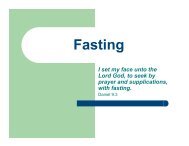Handout - Western Christadelphian Bible School
Handout - Western Christadelphian Bible School
Handout - Western Christadelphian Bible School
Create successful ePaper yourself
Turn your PDF publications into a flip-book with our unique Google optimized e-Paper software.
afraid” - clearly a description of Israel’s condition before the Lord’s return and therefore<br />
before the establishment of God’s kingdom.<br />
Incidentally, speaking of the time that is to follow their deliverance from Gog, God says he<br />
will never again hide his face from his people (Ezekiel 39:29) and that they will never again<br />
be permitted to pollute God’s Holy Name (Ezekiel 39:7). This implies (notice the deduction)<br />
that the Gogian invasion is the last time that Israel will ever be punished for their sins by an<br />
invading army. And this invasion takes place before the return of Christ (to deliver them and<br />
then set up the kingdom).<br />
So parallel passages are an important way to converge on scripture teaching. But their<br />
reliability is limited to the level of confidence associated with their underlying direct<br />
statement(s), and we need to take great care that the parallelism is not merely superficial - or<br />
is otherwise contradicted by the respective contexts of the passages being compared.<br />
By the way, scriptural types, and parables, may be regarded as a particular kind of<br />
parallelism.<br />
4 The Scientific, or Hypothetical, Method<br />
In this case, when confronted by an obscure passage, we guess at its meaning, and then<br />
assemble corroborative facts in support of our guess. This is the way that scientists proceed if<br />
the objects of their investigations are beyond direct observation. Of course they don’t call<br />
their hypothesis a “guess”. The usual word is “model”. Nevertheless it is still a guess.<br />
There is nothing wrong with this method - as long as we are aware of its limitations. We<br />
constantly use it and it is very helpful; particularly when making exhortational points. For<br />
example: we may suppose (notice the hypothesis?) that the centurion whose servant Jesus<br />
healed (Luke 7:1-10) is Cornelius of Acts 10. There is not the least direct evidence for this<br />
in scripture; nor can we deduce it from the record. But by applying principles of parallelism,<br />
we may be able to support the hypothesis to the extent that it becomes sufficiently probable<br />
(read, “believable”). In this particular case, examination of the records reveals these common<br />
facts:<br />
(a) Both men were centurions.<br />
(b) They both had faithful, devout servants who were dear to them.<br />
(c) They were both lovers of Israel.<br />
(d) They were both benefactors of the Jewish people.<br />
(e) They were both God-fearing men.<br />
(f) They were both aware of the work of Jesus.<br />
Perhaps further points of similarity might be added, but these may be sufficient to support the<br />
notion that the two individuals are the same man. A single point of similarity would not<br />
cause us to pay much further attention to the hypothesis. Two would make us wonder.<br />
Three or more will progressively rivet our attention.<br />
It should be realised that making the list of corroborative facts longer merely reduces the<br />
probability of error in the hypothesis; but not to zero - it cannot produce certainty. Even if<br />
we could add to the list that both men were left handed, enjoyed driving fast chariots and<br />
wore a particular brand of sandal, we would still be faced, at bottom, with a guess. It would<br />
be a good guess, to be sure, but could not be insisted upon with absolute decision. Unless<br />
there are grounds for believing that the list of corroborative facts allows of only one possible<br />
interpretation (and usually this is highly improbable), even the best-supported hypotheses are<br />
uncertain to a degree. Generally, each new supporting fact contributes progressively less to<br />
the total probability. But even the most thorough collection of supportive facts cannot<br />
Page 11







